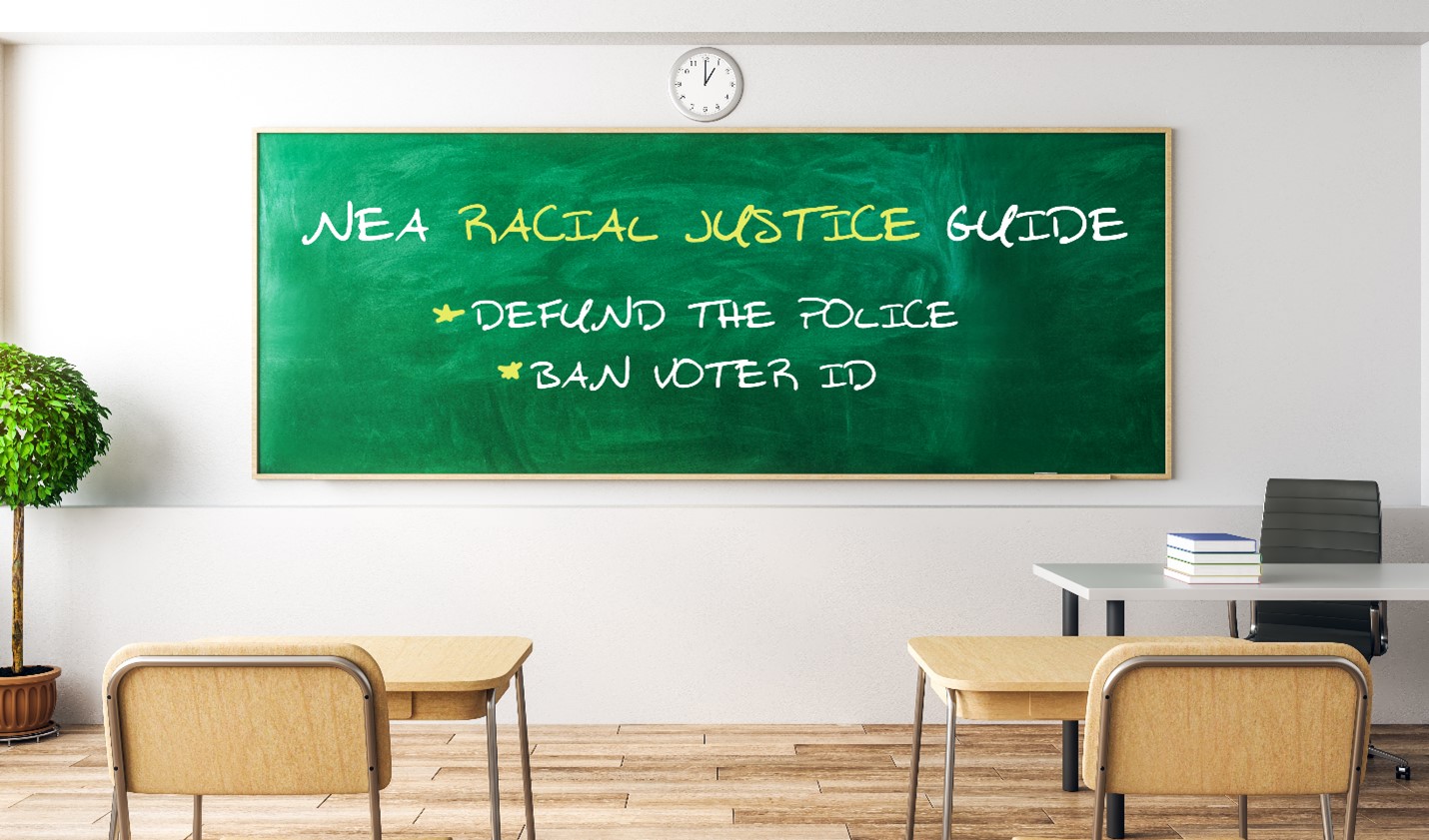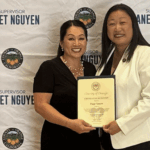A lengthy guidebook prepared by the National Education Association (NEA) and recently discovered by the Freedom Foundation illustrates in stunning detail the degree to which the county’s largest teachers’ union embraces the tenets of critical race theory (CRT) and how this neo-Marxist ideology serves as the basis for the union’s support of a host of damaging and controversial policies like defunding the police and banning voter ID requirements.
Importantly, though it does not appear to have garnered any attention outside of union circles, the guide was first published in November 2018 — well before critical race theory, defunding the police and election integrity were at the forefront of the public’s consciousness — indicating teachers’ unions have been laying the groundwork for these movements for some time.
Following the widespread public exposure to CRT over the past year, teachers’ unions have received much-deserved criticism for their support of this divisive and corrosive worldview, which seeks to define people by their race instead of as individuals and to recast racism as the product of ephemeral and ubiquitous structural and systemic forces, rather than animus harbored in individual human hearts.
Union leaders like Randi Weingarten, president of the American Federation of Teachers, have struggled to respond to parents’ growing concerns over their unions’ backing of this toxic ideology. Weingarten has denied CRT is taught in public schools (she claims it is just “a method of examination taught in law school”) but also pledged to defend teachers who work it into their curriculum.
Semantic arguments aside, Weingarten clearly advocates views about race and American history that many would find both wrong and disturbing, such as her belief that slavery was one of the “foundational principles of our country.”
Becky Pringle, president of the National Education Association, has been more circumspect in her public statements about CRT. But her union — the largest in the country — is every bit as extreme as AFT.
The NEA made headlines earlier this year when, at its 2021 Representative Assembly, union leadership adopted several new business items (NBIs) endorsing CRT. While the NBIs were subsequently scrubbed from the union’s website, they remain available courtesy of the Internet Archive Wayback Machine:
- NBI A: Committed the NEA to eradicating “institutional racism in our public school system” by, among other things, “increasing the implementation of culturally responsive education, critical race theory, and ethnic… studies curriculum in pre- K-12 and higher education” and by opposing “racist laws, policies, and practices, the over-criminalization of communities, students, and families of Native people and people of color, as well as the criminalization of poverty.” Cost: $675,252
- NBI 2: Directs the NEA to conduct opposition research into “the organizations attacking educators doing anti-racist work” through their promotion of CRT. Cost: $56,500
- NBI 39: Requires the NEA to “fight back against anti-CRT rhetoric,” to “oppose attempts to ban critical race theory and/or The 1619 Project” and to join with Black Lives Matter at School and the Zinn Education Project to host a “national day of action to teach lessons about structural racism and oppression.” Cost: $127,600
Importantly, however, these resolutions did not represent a new direction for NEA, but a continuation of its long-running advocacy of its race-fueled, neo-Marxist policies and goals.
For instance, the NEA endorsed reparations via Legislative Amendment 3 at its 2019 Representative Assembly. And at its 2015 Representative Assembly, NEA officials adopted NBI B, which proclaimed “the existence in our country of institutional racism” and directed NEA to launch “campaigns and actions to eradicate policies that perpetuate institutional racism in education” and engage in “campaigns and actions on critical social justice issues.”
The “background” portion of the NEA’s “Racial Justice in Education Resource Guide” — prepared by the union’s Center for Social Justice and the Human and Civil Rights Department — traces the guide’s genesis to NBI B, explaining that “[c]ombating institutional racism and advancing racial justice in education and beyond is at the forefront of the NEA’s vision.”
This sounds innocuous on the surface, but a full reading of the 80-page guide indicates that the union holds views on race many, if not most, Americans would find troubling.
According to the NEA, each of the following is true:
Structural racism is everywhere
“Racial dynamics, disparities and divisions permeate our society, communities, schools and classrooms. Systemic racism is so deeply rooted in our history, culture and institutions that there’s no escaping it. Visible or not, its impacts are ever-present.” (Page 12)
Being colorblind is racist
“Racism is perpetuated by silence—and silence is complicity. Being ‘colorblind’ often serves as a pretense to downplay the significance of race, deny the existence of racism, and erase the experience of students of color.” (Page 15)
Whites are privileged because of their race
“White people are racially privileged, even when they are economically underprivileged.” (Page 34)
“If you are white, you may be used to the privilege of not having to think or talk about race, especially your own.” (Page 15)
Only whites can be racist
“…[R]acism is a cumulative and compounding product of an array of societal factors that, on balance, systematically privilege white people and disadvantage people of color.” (Page 30)
“…[T]he biases of whites have a broader impact and get reinforced by institution and systems of power in ways that the biases of people and communities of color do not.” (Page 23)
“Systemic racism — inequities and ideas about race based on history, institutions and culture — routinely advantages white people and dis-advantages people of color. Some racism is conscious and intentional, but a lot of racism is unconscious and unintentional (also known as implicit bias). Racism can be intensified by other intersecting inequities, such as gender and class, thus race requires explicit, but not exclusive attention.” (Page 17)
In a section entitled, “Key Terms and Glossary,” the guide offers the following definition of “racism”:
“‘Racism’ — Historically rooted system of power hierarchies based on race — infused in our institutions, policies and culture — that benefits white people and hurts people of color.” (Page 35)
In line with this reasoning, the guide defines “reverse racism” as:
“A concept based on a misunderstanding of what racism is, often used to accuse and attack efforts made to rectify systemic injustices. Every individual can be prejudiced and biased at one time or another about various people and behaviors, but racism is based on power and systematic oppression. Individual prejudice and systemic racism cannot be equated. Even though some people of color hold powerful positions, white people overwhelmingly hold the most systemic power. The concept of ‘reverse racism’ ignores structural racism, which permeates all dimensions of our society, routinely advantaging white people and disadvantaging people of color. It is deeply entrenched and in no danger of being dismantled or ‘reversed’ any time soon.” (Page 36)
Failure to take antiracist actions is racist
“In our own classroom, we are the power-holder, the gatekeeper, and the standard setter. One choice is to unconsciously and passively perpetuate racism, while the other is to consciously and actively pursue racial equity.” (Page 13)
“Talking about racism is just a start. Taking action is the biggest driver of change. Create opportunities and strategies to move from awareness and analysis to action and impact. You and your students can go beyond the classroom by advocating for equity in your school and school district. Speak up and speak out. Be intentional about supporting more voices and leadership of people of color. And be proactive by proposing bold and concrete solutions that embody the values and vision of equity and inclusion for all.” (Page 20)
The government needs to solve racism
“Depicting government efforts to promote racial equity and inclusion as misguided, unnecessary and/or improper… [u]ndermines support for a significant government role in dismantling systemic racism” and “[s]uggests that if government would just ‘get out of the way’ (i.e., stop infringing on the individual freedom of whites), we could have a ‘colorblind’ country once and for all.” (Page 24)
Fighting racism means supporting left-wing policies
In a section titled, “Action Planning Guidance,” the guide includes a list of “suggested strategies, tactics and a list of partners and resources for state and local affiliates to consider as they devise their strategic plan on racial justice.”
Among the suggested action items are the following:
“Initiate a campaign to eliminate resource officers [police] from schools…” (Page 52)
“Work on campaigns or initiatives that attempt to divest from prisons…” (Page 52)
“Join state comprehensive immigration reform campaign/s…” (Page 58)
“…[D]efend Dreamers from the latest attacks from the Trump administration.” (Page 59)
“Use arts and culture to engage students and teachers in activism to interrupt attacks on immigrants and advocate for immigration reform.” (Page 58)
“Support Black Lives Matter events and efforts to remove public symbols of racism and white supremacy. Start or support a campaign to remove statues or change school names that celebrate white supremacy or demean people of color.” (Page 63)
“Start or join a campaign to pass automatic voter registration policies in your state. Start or join a campaign in your state to fight voter suppression, voting ID requirements, criminal re-enfranchisement and gerrymandering.” (Page 75)
Conclusion
Although the guide appears to have been released nearly three years ago, it does not appear to have been noticed beyond the union echo chamber. While union executives are shrewd enough to avoid making statements like these in public, their real agendas deserve to receive additional scrutiny.
Perhaps more stunning than the guide’s contents, however, is how precisely — indeed, almost prophetically — events since 2020 tracked with the actions recommended by the NEA, from defunding the police to woke mobs tearing down statutes of public figures deemed offensive.
Given their broad influence over public education, all Americans who care about the preservation of American values would do well to take the agenda of unions like NEA and AFT very seriously.












